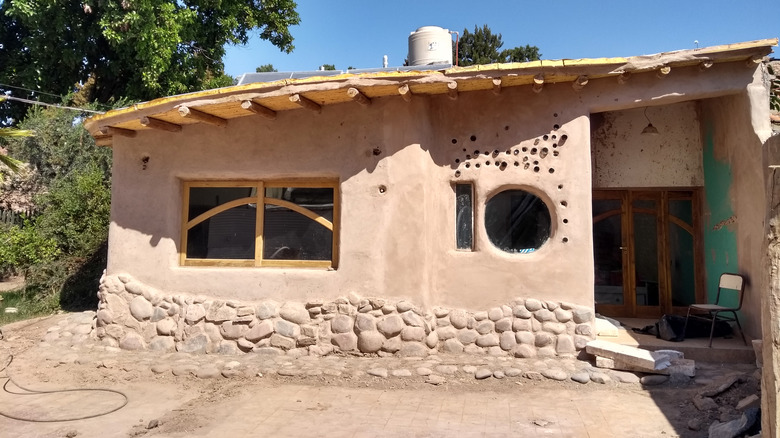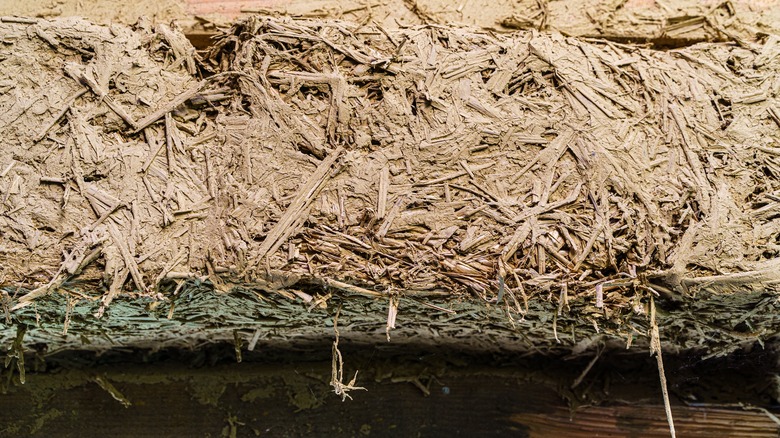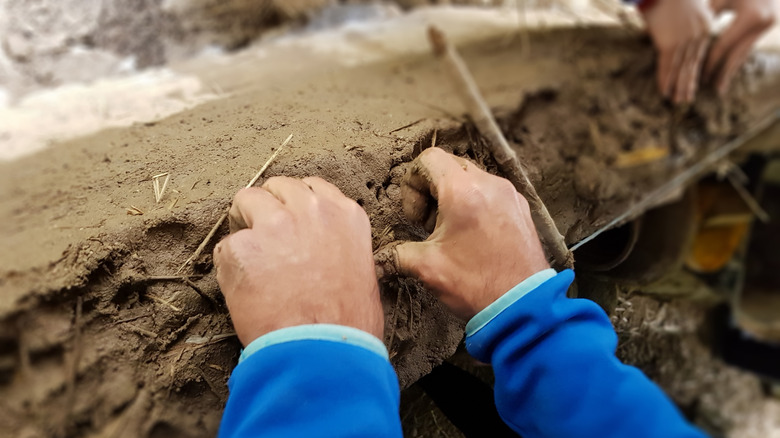Does Your State Allow A Cob House? (And Whether It's A Good Idea)
From earthships to container homes, sustainable architecture only continues to get more popular. One type of building that's making its way out of the off-grid margins is the cob house. Made of a mixture of clay, straw, water, and sand, cob houses may be new to many folks in the United States, but they've been around for thousands of years and have been known to last for centuries. While building codes in the U.S. are only just starting to catch up, and you'll want to brush up on how to navigate getting permits, it's possible to get a cob house permitted in any state.
The ancient technique of cob building has long been used in the U.K., the Middle East, West Africa, China, and Northern Europe, among other places. It involves shaping the clay mixture into walls layer by layer until they're sufficiently thick. There are several reasons cob houses are becoming more popular stateside. Unlike some green building methods, it's very affordable, with costs as low as $5,000 if you do it yourself. The DIY-ability is also part of the appeal: Anyone can learn to build with cob, and it's a flexible material that allows you to create custom, unique designs with an organic vibe.
But most U.S. residents have to comply with local regulations when building on their property. And when it comes to building codes, going green is one thing — building a house out of mud is another. However, times are starting to change. A few years ago, cob houses were added to the International Residential Code for the first time. Several states have adopted this new code, including California and Oregon, and there are workarounds in the states that haven't.
Building codes for cob explained
Cob houses have similarities to other sustainable houses that have been popular in the U.S. in the past, including adobe and straw bale homes. Yet, until relatively recently, cob houses existed outside of the realm of building codes altogether. They weren't illegal per se, they just weren't accounted for. However, in 2021, the International Residential Code (IRC) added a section of guidance for cob construction, which allows builders to get a permit by demonstrating the cob's safety with shrinkage and strength tests.
The IRC is used as a basis for local building codes in most of America, but each city, county, and state makes its own decisions on which parts of the IRC to adopt. In other words, regulations for cob houses still vary, even within the same state. States that have adopted the IRC's cob house guidance include California, Oregon, and Washington, as well as some counties in Colorado. Check your county's building codes to see if cob or "monolithic adobe" is specifically mentioned, or contact your local building department.
Additionally, many building codes allow "alternative" structures and materials, including cob houses. This route requires extra documentation and testing to prove that construction is safe. It can be a costly and difficult process, but the IRC's guidelines may help streamline it for new builders. It's also easier to get a permit for a cob house in a region with other earthen building codes, such as New Mexico, where adobe homes are popular. Lastly, some (mostly rural) counties in America have no building codes at all, making it legal to build a cob house there.
Is building with cob a good idea?
As an eco-friendly alternative to traditional insulation and construction, cob building stands out, saving 75% on construction-related energy compared to traditional wall-building. Cob also has a high thermal mass, allowing it to help regulate indoor temperature and keep you comfortable throughout the seasons. The material is fire-resistant and, as ancient cob houses demonstrate, highly durable. If you're willing to put in the sweat and time, a cob house may be for you.
Many of the same pros and cons of living in an adobe house apply to cob houses. Such houses are generally best suited for warmer, drier climates. It's not as ideal for cold regions where temperatures remain below freezing during the daytime for part of the year. That's because the insulation value of cob isn't very high. The house would require passive solar heating or another solution to make up for the loss of heat through the walls. Similarly, cob is not ideal for regions that may experience flooding or intense rainy seasons, since it can be damaged by moisture. Also, the building process will take longer in humid climates since the mixture needs to fully dry between layers. That said, there are advocates for adapting cob houses to cold climates.
If you live in an area that's not well-suited to a cob house, you can still experiment with this building technique by building a beautiful garden cob wall. Alternatively, look into other earthen building techniques like straw bale, earthbag, wattle and daub, light straw-clay, and rammed earth.


